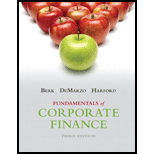
Acquisition:
An acquisition can be defined as a corporate activity wherein a firm purchases most, even though not all, of the shares of a firm so as to assume control over it. An acquisition takes place when the acquirer acquires more than fifty percent ownership in the target firm.
The acquirer normally busy the stocks and other assets of the target firm, thereby allowing the acquirer to take decisions related to the newly acquired assets without the consent of the shareholders of the target firm.
Diversification:
Diversification can be defined as a technique used to manage risks by mixing a group of different investments in a particular portfolio. Its chief objective is to yield higher returns generate lower risks as compared to individual investments in the portfolio.
To determine:
The reason why managers must not acquire firms in different industries to diversify a company.
Want to see the full answer?
Check out a sample textbook solution
Chapter 22 Solutions
Fundamentals of Corporate Finance (3rd Edition) (Pearson Series in Finance)
- If a bond has a face value of $1,000, a coupon rate of 5%, and pays interest annually, what is the annual interest payment? A) $50B) $100C) $500D) $5 need helparrow_forwardIf a bond has a face value of $1,000, a coupon rate of 5%, and pays interest annually, what is the annual interest payment?arrow_forwardIf a bond has a face value of $1,000, a coupon rate of 5%, and pays interest annually, what is the annual interest payment? A) $50B) $100C) $500D) $5arrow_forward
- No ai gpt ....????arrow_forwardYou invest $2,000 in a savings account that pays 4% interest compounded annually. How much will you have after 2 years? A) $2,080B) $2,160C) $2,081.60D) $2,000steps!arrow_forwardYou invest $2,000 in a savings account that pays 4% interest compounded annually. How much will you have after 2 years? Need helparrow_forward
- A company issues 1,000 shares at $25 each. What is the total capital raised? A) $2,500B) $25,000C) $250D) $2,000arrow_forwardYou invest $2,000 in a savings account that pays 4% interest compounded annually. How much will you have after 2 years? A) $2,080B) $2,160C) $2,081.60D) $2,000need help!!arrow_forwardIf the present value of a future payment of $10,000 in 5 years is $7,835, what is the implied annual discount rate (rounded)? A) 5%B) 6%C) 7%D) 8%explanationarrow_forward
- If the present value of a future payment of $10,000 in 5 years is $7,835, what is the implied annual discount rate (rounded)? A) 5%B) 6%C) 7%D) 8%need step by steparrow_forwardIf the present value of a future payment of $10,000 in 5 years is $7,835, what is the implied annual discount rate (rounded)? A) 5%B) 6%C) 7%D) 8%Need helparrow_forwardIf the present value of a future payment of $10,000 in 5 years is $7,835, what is the implied annual discount rate (rounded)? A) 5%B) 6%C) 7%D) 8%arrow_forward
 Essentials Of InvestmentsFinanceISBN:9781260013924Author:Bodie, Zvi, Kane, Alex, MARCUS, Alan J.Publisher:Mcgraw-hill Education,
Essentials Of InvestmentsFinanceISBN:9781260013924Author:Bodie, Zvi, Kane, Alex, MARCUS, Alan J.Publisher:Mcgraw-hill Education,

 Foundations Of FinanceFinanceISBN:9780134897264Author:KEOWN, Arthur J., Martin, John D., PETTY, J. WilliamPublisher:Pearson,
Foundations Of FinanceFinanceISBN:9780134897264Author:KEOWN, Arthur J., Martin, John D., PETTY, J. WilliamPublisher:Pearson, Fundamentals of Financial Management (MindTap Cou...FinanceISBN:9781337395250Author:Eugene F. Brigham, Joel F. HoustonPublisher:Cengage Learning
Fundamentals of Financial Management (MindTap Cou...FinanceISBN:9781337395250Author:Eugene F. Brigham, Joel F. HoustonPublisher:Cengage Learning Corporate Finance (The Mcgraw-hill/Irwin Series i...FinanceISBN:9780077861759Author:Stephen A. Ross Franco Modigliani Professor of Financial Economics Professor, Randolph W Westerfield Robert R. Dockson Deans Chair in Bus. Admin., Jeffrey Jaffe, Bradford D Jordan ProfessorPublisher:McGraw-Hill Education
Corporate Finance (The Mcgraw-hill/Irwin Series i...FinanceISBN:9780077861759Author:Stephen A. Ross Franco Modigliani Professor of Financial Economics Professor, Randolph W Westerfield Robert R. Dockson Deans Chair in Bus. Admin., Jeffrey Jaffe, Bradford D Jordan ProfessorPublisher:McGraw-Hill Education





